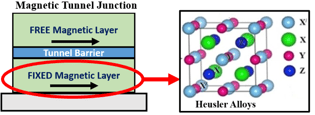Investigating the Electronic and Magnetic Properties of Equiatomic Quaternary Heusler Alloys for Spintronics
Student: Eesha Andharia
Degree: Ph.D., August 2022
Major Professor: Dr. Bothina Manasreh
Research Area(s):
Microelectronics
Modeling and simulation
Background/Relevance
-
Magnetic Tunnel Junctions (MTJs) are a type of Spintronics devices that find wide application in Magnetic-Random-Access -Memory (MRAM).
-
Tunnel-Magneto-Resistance (TMR) of these devices is the key parameter for testing the performance of these MTJs and it depends on high spin-polarization of the fixed Ferromagnetic electrode.
Innovation
-
Use of Quaternary Heusler Alloys (QHA) as a candidate material for the fixed Ferromagnetic electrode for improved TMR values even at Room Temperature (RT).
Approach
- Simulating quasi-particle band-structure of QHAs using VASP code.
- Preserving the half-metallicity of these QHAs in its 2D thin-film form using Ab-initio thermodynamics using Wein2k.
- Calculating the TMR values of QHA/MgO/CoFeB based MTJs using Micro-magnetic simulations.

Key Results
- Optimization of crystal structure of QHA –CoFeMnSi using Wien2k code.
- For a Face-centered-cubic (FCC) crystal structure, the lattice parameters obtained using PBE functional within the framework of Density Functional Theory (DFT) are a=b=c=10.5962 Bohrs.
- Testing convergence with respect to overall E-cut_off (cut-off energy) , which is a product of RMT (Radius of Muffin Tin Orbital) and Kmax (Cut-off for the kinetic energy of plane waves) was 9.0 Ry.
- Convergence was also tested w.r.t K-mesh and was achieved for as high as 2000 K-points.
Conclusions
-
Optimization of lattice parameters and atomic positions obtained using Wien2k code.
-
Self-consistent-field (scf) calculations have been undertaken using Wien2k code and the fermi energy Ef = 0.7643 eV.
Future Work
-
Undertaking GW calculations to obtain the Quasi-particle band-structure of bulk and 2D QHAa – CoFeMnSi/Ge and CoFeCrSi/Ge.
-
Using Ab-initio thermodynamics to study the surface stability of 2D QHAa.
